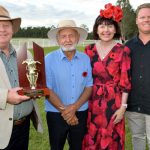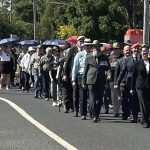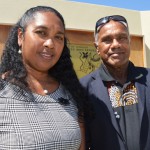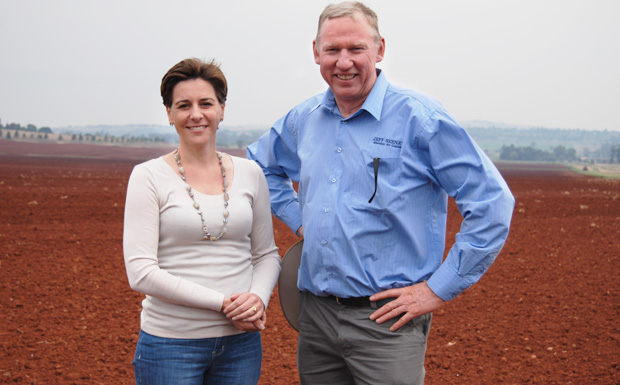
February 13, 2013
Queensland State Parliament held its first sitting day for 2013 yesterday but suspended normal business so that MPs could express their condolences to victims of the Australia Day weekend floods.
Parliament observed a minute’s silence as a mark of respect for the six people who lost their lives during the flood crisis, as well as those who lost their homes and livelihoods.
Premier Campbell Newman opened the proceedings, speaking of the need to rebuild better and stronger.
“Building like for like will get you the same result. We must build back better. We owe this not only to those who lost their lives, but to those who have lost their livelihoods and their homes,” he said.
Individual members then rose to give their support to a motion of condolence for flood victims, with members whose electorates had suffered flood damage recounting the experiences of their constituents.
From Hansard, here is the text of the speeches given yesterday by Member for Nanango Deb Frecklington and Member for Callide Jeff Seeney:
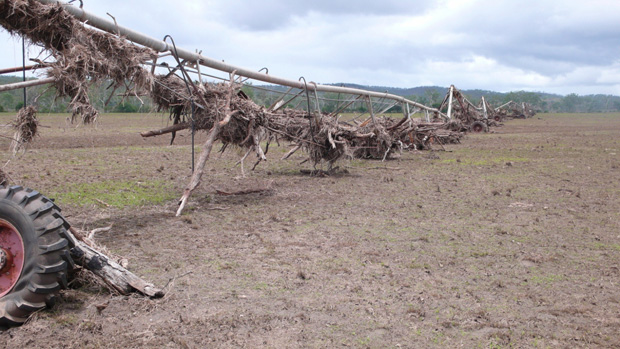
Deb Frecklington, Member for Nanango:
I rise to support the condolence motion and express my sincere condolences to those families and friends who lost loved ones during the devastating floods of the Australia Day weekend 2013.
Before I talk about the damage done across the Nanango electorate I believe it is important to note that the regions of the South Burnett, Somerset and some parts of the Crows Nest-Goombungee areas have not yet finished the recovery process from the January 2011 floods.
Our roads are still being repaired, farmers are still building fences, businesses were seeing out a slow economic recovery and the community was still coming to terms with what had been lost.
This is why the impact of these floods just some two years later is so much harder than before.
Whereas people had the hope that they had climbed back out of the troubles of the January 2011 floods, they are now back to where they began wondering how to start over again.
In the South Burnett we have seen major flooding in the Barker Creek and the Wattle Camp areas. The Barambah Creek, which flows into the Callide electorate, has totally devastated the farming districts of Byee and Silverleaf and there was serious flood levels in Cherbourg and Murgon.
It is important to note that much of the water that flows into the Burnett and, ultimately, Bundaberg comes from some creeks and rivers within the northern part of the Nanango electorate. The catchment extends from the Bunya Mountains and Nanango to the west near Durong. The amount of water that flowed through these systems was simply enormous.
I would like to also pass on my thoughts to the members of this House and their constituents but in particular the members for Lockyer, Scenic Rim, Burnett, Bundaberg, Gympie, Hervey Bay, Maryborough, Gladstone, Logan and, most importantly for people in the northern end of my electorate, Callide.
I would also like to acknowledge the leadership of the Premier, the Deputy Premier and the Minister for Resilience, David Crisafulli, for the decisions that have been made during this time.
Australia Day started for me with a breakfast in Esk and then I went to enjoy the Kilcoy races. The Kilcoy races have been rained out on four occasions. So it was with pleasure that I did attend the races, although it was raining quite heavily and only three races were run.
By the time I woke up early on Sunday morning, the amount of rainfall was simply incredible. It had gone from being the driest January in many years and many seasons to the wettest January overnight.
This heavy rainfall overnight isolated the towns of Wondai, Kingaroy and Nanango.
Not only was there the isolation and our roads cut off; it meant that our emergency services had to deal with these issues with limited staff.
It was a long weekend and, as always happens in small country towns, a lot of staff go away for the weekend.
In particular, I pay tribute to Senior Sergeant Duane Frank in the Kingaroy police district who handled the small number of staff that he had that weekend with great courage.
This led to many interesting decisions in the South Burnett disaster management group, and I just wanted to touch on some of them.
I mention the Smithfield Feedlot, which is in the Deputy Premier’s electorate of Callide. This was an interesting situation in that the Proston-Boondooma Road had been completely washed out which left some 18,400 head of lot-fed cattle stranded on the other side with no way of having feed.
They only had some three days of feed left, and there were obviously livestock issues with the 18,400 head of cattle.
It was wonderful that the South Burnett Regional Council was able to fix that road expeditiously and hence alleviate any problems.
There were also 110 people who mainly had been holidaying at Boondooma Dam who were stuck in Proston. I want to thank the Proston community for looking after those people for so long.
Jason and Susan Kinsella from Moffatdale Winery were lucky enough to have a tourist bus stranded at their winery. Not only did the tourists enjoy the company of Moffatdale wines, but I do believe the Kinsellas had a very good weekend as well.
Some 250 people were also stranded at Manar Park. Credit goes to the South Burnett council and how it managed food drops into Manar Park. Some 250 people is a lot of people to feed when they are stuck in caravans or camping.
The extent of road infrastructure problems in the South Burnett Regional Council is quite extensive.
An example of this is the Burabru Crossing at Burrandowan. Moloneys Bridge has been completely washed aside and now represents a boardwalk. What this means to people like Tom Hoare is that it is at least an extra 50 kilometres to get in and out of town.
Those crossings had only just been finished some one month or two weeks prior to this flood event.
I also want to pay special tribute to Russell Hood of the South Burnett Regional Council who looked after the water infrastructure. The Nanango township got down to nine per cent water one night. The workers from the South Burnett Regional Council worked in awful circumstances in order to ensure that the township of Nanango did have water.
It is important to note, however, that the township of Cherbourg was without water for at least a day. I do thank Russell Hood for the leadership that he took.
I also want to thank Ergon which assisted those in the South Burnett with limited communication resources, and it really did provide a wonderful service. There is a great newspaper article on South Burnett Online about Ergon workers who were servicing a pole in the middle of a flowing river and putting their lives in serious danger.
Nanango State School suffered quite extensive flooding to its grounds and its prep class was about 20 centimetres off being flooded. However, its special needs room was completely flooded.
This is a great story in that principal Lyal Giles needs absolute credit as do the 50-odd parents of the P&C of that school who cleaned up that school to enable the school to commence on its correct date.
That was all done whilst Nanango was completely isolated. Whilst there were a lot of people from the surrounding districts who wanted to get in to help clean up that school, they were simply unable to.
The children have now been able to get back to school. Unfortunately some of their play equipment is still damaged, but it was a wonderful credit to the principal and the parents of the P&C.
In circumstances like this I think it is important to note the wonderful contribution that the local media play, particularly in an area like the Somerset and South Burnett which are not covered by the national or state media.
Little radio stations such as CROW-FM in the South Burnett and Valley FM and also South Burnett Online and our local newspapers, which went online, produced a lot of information.
It was wonderful to see that my Facebook page was used very well to give minute-by-minute updates of when we could and could not get out on roads, as was the local council Facebook page. It really is a way of the future as to how we will be able to deal with further disasters, hopefully not in our time.
It is also important to give some examples of some of the devastated farmers around my electorate.
I had the opportunity to visit Mark Black’s property at Brooklands. Mark explained to me extremely eloquently how this crop – that is, the crop we were standing in that was just a clay pan with no crop left – was the crop that was going to get him back on track after the 2011 devastation.
He told me how for 24 hours he wondered whether he should bother getting back into his property and fixing it up. He was constantly considering the debt level that he had gone into from the previous flood and whether he could get back up again. He lost 140 acres of soy beans, his irrigation pumps and his fencing, but most important to note is that he lost his topsoil.
It will cost him a lot for him to put that topsoil back. Even with the money he spends – and it is important to note this – on replacing that topsoil, it will take a couple of years before that land can recrop.
He also showed me Barkers Creek, which has an erosion problem, and what it has done to the paddocks around that area.
I also want to speak on behalf of the Pennells.
Belinda is my electorate officer. She actually lives in the Callide electorate just outside of my electorate. She suffered devastating losses to their property. She was also flooded in for over a week.
They estimate that they have lost up to $300,000 in irrigation infrastructure, fencing, pumps, contour banks and stock. They had not rebuilt since 2011 and her family must simply start again.
For those living along the banks of the Boonara, which ultimately ends up in the Burnett River and then Bundaberg, the water came faster and higher than in 2011. It came at night and rose six metres in four hours. Historically, that is not what this creek system does.
Not only did they lose power, but that meant that they could not monitor the creek height on the BoM website.
When they went to bed on the Saturday evening, there was only less than one metre in that creek. They thought that if it did flood, which it was not predicted to do, they had 24 hours for the water to reach their property which would enable them to move their important infrastructure.
That did not happen.
By midnight that creek had reached major flood levels and by early Sunday morning it was the height of 11.39 metres.
They are only some examples from over the South Burnett regional shire.
But we must not forget the other important region of the Somerset. The Somerset had 35 homes inundated, 60 farms suffered water inundation and 240 farms lost crops and machinery.
I pay tribute to Mayor Graeme Lehman of the Somerset Regional Council who kept me informed on an almost hour-by-hour basis because I was unable to get to the Somerset region as I was isolated in Kingaroy.
It was extremely devastating to not be able to get down and around that community of the Somerset.
I would also like to pay tribute to the local people who helped out in the evacuation centres at Esk, Toogoolawah and Kilcoy. As we know, the Kilcoy Bridge gets cut off because of the flooding that happens in that area.
As soon as I was able to get down to the Somerset, I was invited to visit Roslyn and Andrew Jackwitz’s farm at Clarendon. This farm is located in the southern-most area of the Nanango electorate.
To say it was devastating to stand on the Jackwitz’s property and see what was lost is an understatement.
It really pulled at the heartstrings to hear Andrew Jackwitz talk of the lost crops of vegetables – the paddock of pumpkins that were ready for harvest – and the wonderful stories of his 20-odd staff who came and cleaned up their flooded house, their flooded packing sheds and their devastated paddocks that are now claypans.
I also talked to them to work out how they are going to get going.
I pay credit to the Minister for Agriculture, Fisheries and Forestry and his department for recognising the help that these people will need.
The Somerset and Wivenhoe dams are located within the Nanango electorate and, in regard to the heights and releases of these dams, our Premier and his team made the sensible and correct decisions.
I am constantly told by people in that area that they would like to express their gratitude for the early intervention of our Premier in relation to the dams.
I relay correspondence from Mr Greg Banff of Coominya in the Somerset, who wrote “The State Government needs to be commended for a well-managed disaster relief effort. Especially the shutting down of Wivenhoe Dam to allow Lockyer, Buaraba and Bremer Creeks to discharge flood waters.”
This story was also relayed to me by Trevor Stretton, who lives on the banks of the Somerset, as he praised the early decision making as the releases essentially prevented the Somerset from backing up and flooding Kilcoy.
I also want to talk very briefly about the upper catchment of the Stanley River. That area has lost numerous crossings and some people in that area are still isolated. They are such resilient people up there. They have not had anywhere near the damage that they had in 2011, but their resilience is simply
amazing.I would like to thank the Deputy Premier, Jeff Seeney, the Minister for Local Government, Community Recovery and Resilience, David Crisafulli, and the Minister for Agriculture, Fisheries and Forestry, Dr John McVeigh, for visiting the electorate and, most importantly, reassuring the people of the Nanango electorate that no-one is forgotten.
I also particularly thank Dr McVeigh and his department for being on the ground with mobile offices and also employing flood recovery officers, one situated in the South Burnett and one situated in the Somerset.
I pass on my congratulations to Mayor Wayne Kratzmann for leading the South Burnett disaster recovery team so ably. He included me in the process and I thank him very much for that. South Burnett Regional Council has estimated the damage to their infrastructure, in particular roads, to be at $65 million and for the Somerset Regional Council, $20 million.
I pass on my gratitude to all of the emergency services. As I alluded to, a lot of these services lost staff as they were away for the weekend and were isolated. Our local SES teams suffered fatigue and the leadership of Arthur Dawson of the SES at Nanango is very much appreciated.
I would like to make particular acknowledgements of Mark Long of the Queensland Rural Fire Service, who led by example in relation to the food drops and the services that his team provided.
I also would like to thank to my electorate staff Belinda Pennell, who, as I have mentioned, was so disastrously affected by these loods and who has since spent some time in hospital. I also thank my electorate officer Jacki Vreeken, who worked overtime taking calls on the weekend and helping out all the constituents who had so many community service problems.
Jacki’s sister’s property in North Bundaberg was completely flooded, as was her business.
I would also like to pay tribute to the member for Burnett, as he very ably looked after his electorate whilst his own home was inundated. I thank him for taking such a lead role in his electorate.
I also would like to pass on my gratitude to the Federal Government for recognising the farmers within the Nanango electorate who so desperately need that Category C acknowledgement.
Finally, I would like to thank everyone who I have not been able to mention in this recovery effort.
So many volunteers and emergency service personnel in the Somerset worked throughout the weekend and continue to work in the flood recovery process which, for many people in my part of the world of Nanango, will take many years.
I commend the motion to the House.
Jeff Seeney, Deputy Premier and Member for Callide:
I rise to support the motion moved by the Premier and to join with other members of this House in expressing my condolences to the families of the six people who lost their lives in the 2013 flood event.
In particular, I extend my condolences to the family of Jacob Shearer, a 27-year-old constituent of mine who lost his life tragically at Widgee.
The 2013 flood event came as something of a surprise, I think, to many Queenslanders still recovering from the 2011 natural disaster.
It was very different to the 2011 situation in that the 2011 flood event and the natural disasters came at the end of a long wet season. In Central Queensland in 2013 the wet season had not arrived. It was a season that was very dry. So when ex-Tropical Cyclone Oswald started to move south it was welcomed by many Central Queenslanders as a chance for some long overdue rain, and rain it did.
The sort of rain that the member for Hinchinbrook and his colleagues in North Queensland are well used to was visited on us in Central Queensland. Some of the rainfall totals were quite amazing. Some of the rainfall totals that fell over a period of three or four days exceeded what had long been considered to be annual averages.
In the ranges behind Gladstone there were recordings of up to 40 inches of rain over a three-day period — 40 inches of rain in an area where the annual average is not 40 inches.
But in those ranges behind Gladstone is where the river systems that run through the electorate of Callide originate — the river systems that run north to the Dawson — the Callide and Kroombit creeks; and the river systems that run south to Bundaberg down the Burnett Valley — the Burnett River, Three Moon Creek, Splinter Creek and Monal Creek. All of those systems originate in those ranges and they all flooded, as you would expect with that volume of rain. They flooded in a way that few could imagine and that a lot of us struggled to believe.
The first flooding occurred in Biloela and Monto on the 26th, the Saturday night, because those places are closest to where the systems originate. In Biloela, especially, I want to commend the people who responded there. There were emergency releases from the Callide Dam which caused concern in the community. It required an increased number of evacuations. There were evacuations in both Biloela and Monto in areas that had never been evacuated before. I commend all of the people who were involved in those evacuations.
There was major flooding downstream on Saturday and Sunday as Tropical Cyclone Oswald lingered. I saw some of the early weather reports that suggested that the system would move south of Brisbane very quickly; it did not. It lingered over the Burnett, over the Wide Bay, over the southern part of Central Queensland, and those rainfall totals that had fallen originally in the ranges west of Gladstone were repeated further down the coast and almost all over the Wide Bay-Burnett region. That resulted in a flood that few people could have anticipated.
Those of us who have grown up in the Burnett have grown up with stories about the 1942 flood — it is almost part of the local mythology. I remember many times raising my eyebrows and shaking my head at the stories that my father and my grandfather and their generations told about the 1942 flood. A lot of us did not believe it; we believe it now because this flood in many places surpassed the levels that were recorded in the 1942 flood.
In Mundubbera, for example, the flood of 2013 was four metres above the flood of 2011 — four metres higher. In Gayndah it was three metres above the flood level of 2011.
The official rating in Mundubbera put the flood of 2013 at just below the level of the great flood of 1942. However in areas north of Eidsvold the flood of 2013 was three or four metres higher than the 1942 flood, such is the nature of these events that it is not consistent across the river system.
It was the shock of seeing those levels of 2011 and of 1942 surpassed that caused such great anguish to people and such great damage to property across my electorate.
Some 300 houses were inundated — 100 houses in and around Mundubbera; almost a third of the town of Mundubbera was inundated — and 35 businesses. The Premier mentioned the Golden Orange Hotel, the Billabong Motor Inn, the Three Rivers Tourist Park and the Riverview Caravan Park in Gayndah. They are major businesses that suffered inundation because there was not enough warning to effectively do anything about it because it was so unexpected.
Importantly, every agricultural enterprise along the river system also suffered enormous damage. In the Burnett, agriculture is centred along the river, especially the high value agriculture. The citrus orchards, the irrigation farms and the horticultural industries are centred along the river and the damage to those agricultural businesses was devastating. It surpassed anything that has been seen in recent times and certainly anything that was expected.
Disturbingly, entire intensive piggeries were inundated. Entire dairy herds were swept away. The damage to the citrus orchards and the infrastructure that they depend on will take a long time to repair.
The whole Burnett was without electricity for four to five days.
One of the first things that we lose in regional Queensland in these events is access — access from one community to the other, access to the major regional communities — and most communities lost access for four to five days. That presents a situation where communities have to do it on their own. They have to do everything for themselves. I commend so many people in the community who did just that, who rigged up water pumps to ensure that the town water supply was maintained — if it was not well maintained, then at least it was maintained.
In each one of the Burnett towns of Monto, Eidsvold, Mundubbera and Gayndah the water supply was damaged by the floods. In each situation innovative solutions had to be applied while the towns were isolated until such time as we could get resources into those towns to effect proper repairs.
One of the most debilitating effects on those communities was the fact that they lost communications for a period of 24 hours —completely lost communications. There was no phone, no internet, no communication with the outside world. I have heard stories of people who sat in their cars listening to the car radio to find out what was going on in the rest of the world. The failure of communications for a 24-hour period — and communications were not good for a further 48 hours — was one of the reasons that there was a degree of community angst and a feeling by some people that they had been forgotten.
Of course, they were not forgotten. Those communities were in everybody’s mind as the emergency services struggled to deal with the flood as it moved further downstream. The flood that had passed these Burnett communities was affecting the community of Bundaberg in the way that my colleague the member for Bundaberg has already outlined.
When we were able to restore access to those communities the emergency services response in the Burnett was swift and it was effective. Before that emergency service response was able to be put in place the responsibility for each of those communities fell to the local government representatives in those communities.
I want to pay particular credit and make particular reference to them today — to Ron Carige and Warren Middleton of the Banana Shire Council, who led the local government’s response there. I think their local disaster management committee is a model that can be used by other communities. To Warren Middleton, Ron Carige and their team I say congratulations on the great job they did.
I say the same to the councillors in the communities in the North Burnett Regional Council area. The North Burnett Regional Council area is unique in that it contains six towns that were immediately isolated from each other. So each town, each community and each councillor had to deal with their own particular situations.
I acknowledge Don Waugh, the mayor of the North Burnett Regional Council; Faye Whelan, the deputy mayor from Mundubbera who ran the community response almost singlehandedly; Paul Lobegeier in Monto; and Paul Francis and other councillors who took on the role far above what anyone would imagine is an elected councillor’s role in emergency situations. Their role as a local councillor, as a local community leader, enabled those communities to deal with the situation until such time as access could be restored and the emergency service response could be activated.
When the emergency service response was activated it was effective. We had SES volunteers from a range of other communities and we had the Army.
I want to pay due credit to the Army. It was an enormous morale booster in places like Gayndah, Mundubbera, Eidsvold and Monto when the Army turned up. It was certainly something that the community appreciated and I want to pay due regard to those young men, many of whom seemed ridiculously young to me. Those young men turned up prepared to do anything to assist the community.
They re-established contact. They were able to travel down roads that nobody else could get through. They were able to help catch pigs that had escaped from intensive piggeries. They are a wonderful bunch of young men. On behalf of my communities I
thank them very much for the efforts that they made to come to our communities at a time when we badly needed that morale booster.The recovery effort in the Burnett is well underway. One of the messages that the community wants the rest of Queensland and the rest of Australia to understand very clearly is that they are determined to rebuild their communities. They are determined to rebuild the agricultural enterprises that are the economic base of those communities. Certainly any government assistance that we can provide to do that will be welcomed by those communities, and they have well and truly started that process.
The citrus industry, in particular, is the core of the agricultural economy in communities like Mundubbera and Gayndah. The message that the citrus industry is sending very loudly and very clearly to the people of Queensland and Australia is that, while they have been damaged, they have not been destroyed.
There will be a citrus crop this year. There will be a magnificent citrus crop this year from the central Burnett. What the people of Australia can do is support the Queensland citrus growers when that citrus crop reaches the market. They are determined that they will continue to provide that magnificent product for which they have became so famous.
Equally, local government has embarked on the rebuilding process for the infrastructure. Equally, there is a determination to ensure that this time we rebuild it better and we rebuild with an increased level of resilience. I congratulate my colleague Minister Crisafulli on the responsibility that he has taken on with his new title of Minister for Local Government, Community Recovery and Resilience. Rebuilding the resilience of the essential parts of the infrastructure for our communities will be incredibly important.
It is worthwhile noting the incredible determination of those communities to ensure that that resilience is built into the Burnett Highway, the communication network and the water supply in those towns.
To stand in Gayndah, for example, as Minister Crisafulli and I did, at the water supply intake in Gayndah that was destroyed in the 2011 floods, and which was finally repaired — finally started operation — in December 2012, and which operated for four weeks and then was destroyed again by the floods of 2013, left both the Minister and I with a shared determination to make sure that that sort of nonsense does not continue. We are determined to rebuild that essential infrastructure in a way that has
an increased level of resilience.We stood on the new bridge at Monto, which is $7 million worth of new bridge, which was completed in 2010, washed away in 2011 — not the bridge itself but the approaches to the bridge — repaired after the 2011 flood and washed away again in 2013. It was washed away to the extent that it took two days to gain access. That access is so critical for those communities.
Those are the lessons that we have learnt and learnt very well from the natural disasters of 2011 and 2013, and the communities and the government are determined to ensure that that resilience is built into the recovery effort.
Equally, there is a huge task for people to recover. The resilience of individual people was tested by this natural disaster because it came so soon after the 2011 event.
The resilience of individual businesses to recover financially and the ability for people to recovery emotionally has also been tested. I pay tribute to the work that is being done by the government departments, the support agencies and everybody who has been involved in that effort—and it has been a big effort and it is an ongoing effort. As we speak, those efforts are ongoing in those communities.
I conclude by paying tribute to everybody who was involved in the rescue efforts and the recovery efforts for the communities that I represent. There were many stories of heroic rescues. There are many, many stories of selflessness, of people giving of their own time and effort, of people giving of their own resources at a time when they themselves were under threat. As an example, I wanted to share with the House the story of Lucy Connolly.
I have known Lucy since she was a kid. Her dad, Pat Connolly, suffered from drought for so many years that he decided that he would buy himself an irrigation farm on the bank of the Burnett River. Being a former irrigation farmer, I gave Pat some unwanted advice about the wisdom of that investment, but he bought it.
Lucy lived in the house on the bank of the Burnett River at Ceratodus and on the night of the 25th Lucy found herself in a situation where she had to abandon the house because of the rising floodwaters. She was swept away by the Burnett River and spent five hours in a tree downstream. She was rescued by a bloke called Rodney Hartwig. If Rodney was here, he would be the first bloke to admit that he has always been a mad bugger. He was a mate of mine for years … Rodney tried to get down in a ute to where Lucy lived, but he could not do that. He went back and got a tractor, but could not do that. He ended up with a small boat and they eventually rescued Lucy Connolly five hours after she was forced to abandon the house in a situation where only the crazy brave would go.
But that crazy brave attitude was repeated time and time and time again by people who came to the rescue of others, by helicopter pilots who rescued so many people not only in Bundaberg but in isolated farm houses across the Burnett. These people put their own lives at risk to rescue others.
It is because of the efforts of those people that today the list of people whom we extend our condolences to is only six. The fact that six people died is a tragedy in itself, but without the heroic efforts of people like Rodney Hartwig, people like Jack Hewitt, the helicopter pilot, and so many others, the list of people whom we would mourn today would be so much longer.
I want to pay tribute to all of those people who put their own lives at risk to save the lives of others.








